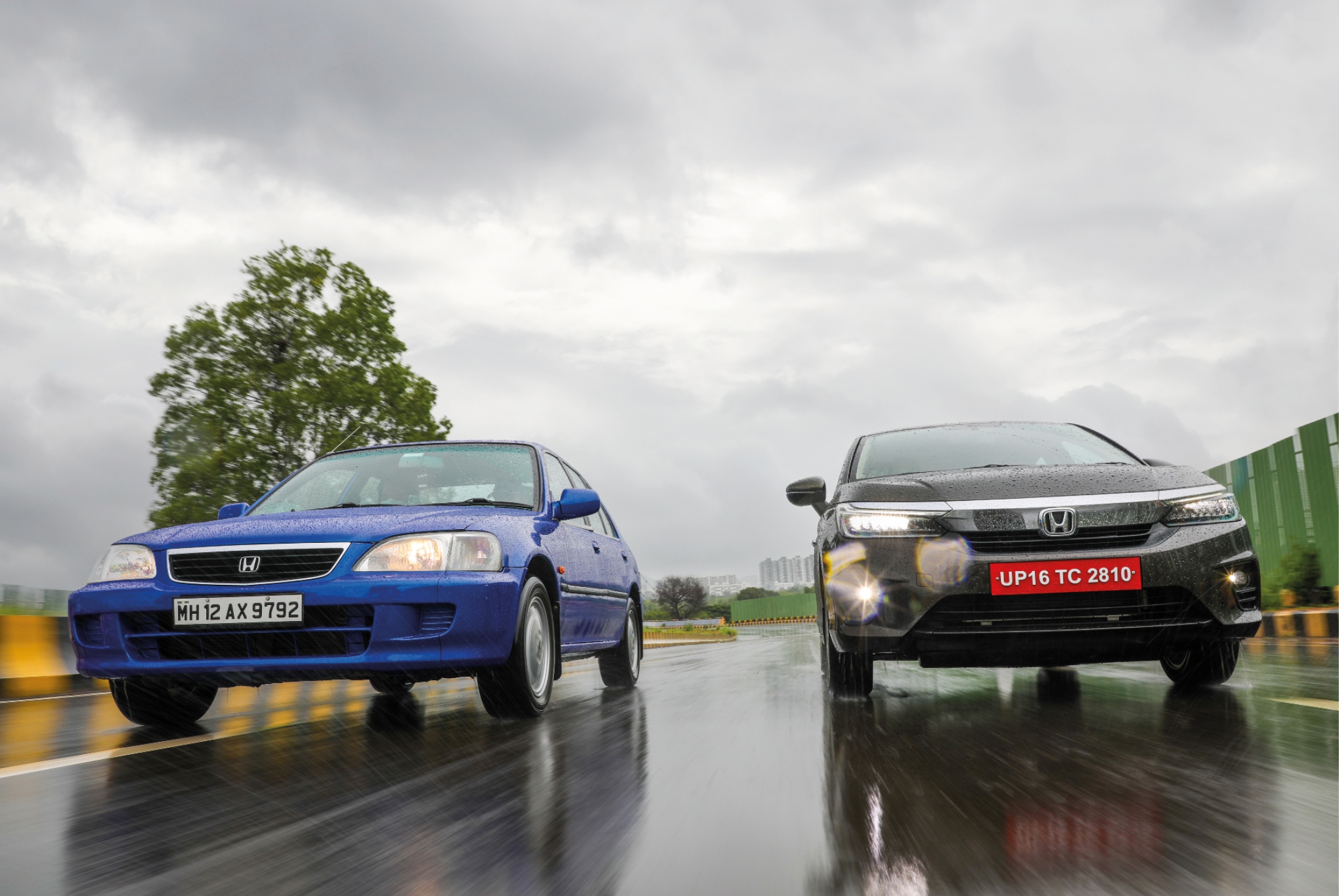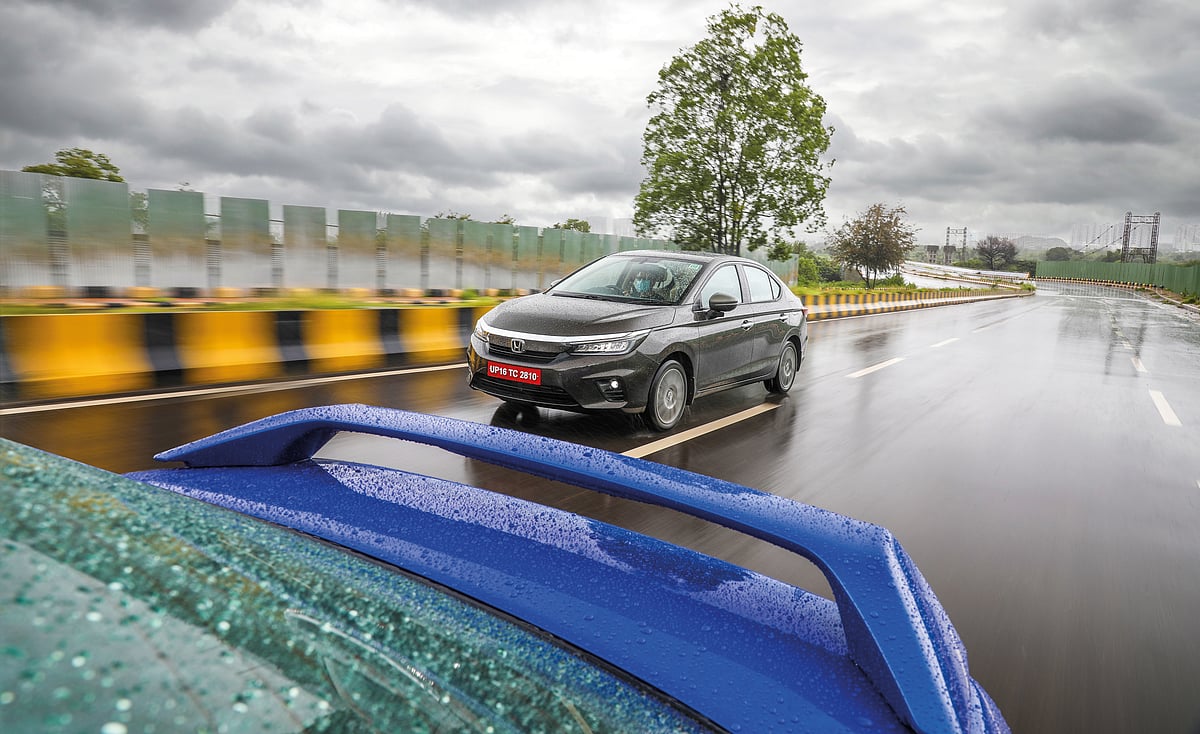Gen 5 Honda City iVTEC vs Gen 1 Honda City VTEC — How it started vs how it’s going
With Max Verstappen’s victory at the Formula 1, we take a look back at the Honda City, and what made us all say “VTEC kicked in yo!”
 Over 23 years of the Honda City in India, it still offers you "a gem of an engine, and a jewel of a car"
Over 23 years of the Honda City in India, it still offers you "a gem of an engine, and a jewel of a car"Honda, maker of the world’s best engines.’
Hard as we tried, back when I started reviewing cars this line would invariably creep into every test involving the Honda City. No matter what yardstick we employed for a particular test, the engine always powered the City to the top. Performance tests, track attacks, drag shoot-outs, tedious fuel efficiency tests, rapid-fire 0-100-0, heck we once even did an air-con test and the City won that too, the engine always being singled out for sumptuous praise. Then came the City VTEC in 2001, and we lost our collective minds. India’s first 100+ bhp engine. India’s first 10-second 0-100kmph car. India’s first, okay second, car with an almighty wing on the boot. India’s first with 14-inch wheels. It made for the country’s most spectacular rally car. Went on to total domination on race circuits (to this day, I must remind you). This was the base for tuners to go nuts. For us the City’s regular Hyper 16 Valve engine was good enough to repeatedly confer it with Car of the Year crowns; the VTEC kicked things out of the park, yo.
They say familiarity breeds contempt. I’m not quite so sure about that, but it sure attaches a hefty suitcase of complacency to both the ankles. In all this mania about the future being electric, we’ve forgotten what a jewel the internal combustion engine is — the hundreds of parts doing the tango, everything balanced to the last tenth, tolerances honed to microns, thousands of tiny detonations harnessed into mechanical energy exploding into howls of delight (or terror) from within the cabin, the acoustics tuned to make the hairs on the nape of the driver’s neck stand on end, the intense emotions that this mechanical event evokes, so much so that we give our cars names and shower them with more tender loving care than is deemed healthy. And when combustion engines are finally mounted on plinths and rolled into museums, a Honda motor will be at the head of the line.
In an Indian context there has been no engine consistently deserving of ‘the best’ tag as the VTECs in generation after generation of the Honda City. The problem that Variable Valve Timing and Lift Control addressed was the dichotomy between smooth power delivery at the low end and a zinging top end. Or, more pertinently in an Indian context, fuel efficiency at low revs and performance at higher revs. By using separate camshaft profiles, both the lift and duration of the valve opening could be adjusted, the ECU switching between the efficient cam and the high-performance cam based on speed, load and revs.
 One drive in the Gen 1 Honda City will put things into perspective
One drive in the Gen 1 Honda City will put things into perspectiveThis was the beauty of the original VTEC in the Type 1 Honda City, enabling it to kick out 106hp at 6800rpm. Variable valve timing, commonplace on the weediest engine today, was an absolute novelty and it made the City VTEC a rocket, the hot cam opening the valves further and for a longer time allowing more air and fuel to enter and burn, thus creating more power and torque. And to control everything was Honda’s Programmed Fuel Injection (PGM-FI) which actually traced its roots to Honda’s Formula 1 engine program. It’s no secret that Honda has motorsport in their veins, ever since Soichiro Honda insisted racing was the only way to develop better road-going bikes and cars. All their engineers — and this is, and always has been, a company led by engineers — cut their teeth in the high-pressure cauldron of motorsport, and then transferred those learnings to bikes and cars for you and me. In fact when VTEC was being developed, the team adopted valve timing and lift settings that were comparable to racing engines to enhance volumetric efficiency thus performance at high speeds. VTEC enabled what was till then unthinkable, achieving 100 horsepower per litre from a naturally aspirated engine. VTEC enabled the S2000 to rev up to 9000rpm and put out an even more insane 120 horsepower per litre, a record that took ten years for Ferrari to better with the 458.
Soichiro Honda had once famously said, “Success is 99 per cent failure”, and it was obvious in Honda’s long journey into developing a world championship winning Formula 1 engine. But this never applied to road cars. There simply are no failures. In our experience VTEC engines, old and new, are the most reliable that you will find anywhere. The most efficient. And the smoothest.
One drive in a Gen 1 Honda City VTEC puts it all into howling perspective. The way the engine revs, all the way to 7100rpm, is insanely evocative. To think that this car is two decades old, the mind boggles, and then does a back flip while hollering in delight as you bang in another gear and charge back up the redline. This original VTEC system controls valve lift and duration but it could only choose between low and high-rpm profiles, and when the hot cam comes on song, you feel a definite step up in the power delivery. And there you are up to speed with how our favourite phrase of the noughties came to be. At 5200rpm VTEC kicked in, yo.
 The i-VTEC is a result of two decades of research
The i-VTEC is a result of two decades of researchEngineers, of course, never sit idle. Two decades of R&D has led to the i-VTEC in this new Honda City that now combines VTEC with VTC (Variable Timing Control). In addition there is DOHC — the older ones were all SOHC — two camshaft profiles helping to optimise and bump power up to 119bhp. While VTEC works to control valve lift duration, the intake cam can now advance from 25 to 50 degrees thus delivering the optimum valve timing for every rev range. The phasing on this L15B engine is implemented by an ECU-controlled, oil-driven, adjustable cam and with one cam controlling the inlet valves the other the exhaust, there is more precise timing. Also since the cams are independent the engine has more freedom to rev, evident when you blip the throttle of this City and the revs rush across the tacho in the free-spirited fashion of the most committed hippie.
In the real world you also notice more low end torque, the VTC advancing the timing to ensure better gas flow and better drivability at low and mid-range. No longer does the City do all its work at the top; pottering around in the city is relaxed, easy and effortless. But that’s at no expense to the top end, this engine redlining at 7000rpm, the highest rev limit for any 1.5-litre engine in the country. Hang on, I think this is the highest revving production engine in the country today, this side of a 911 GT3. How come no one talks about that! And I must specifically point out that these are not revs for the sake of revs. Most engines, the power peaks well before the redline and then it tapers down till the limiter eventually cuts in. That’s why we keep saying it’s better to short-shift rather that scream all the way to the top. Not in a Honda. In this i-VTEC the flow increases as the revs rise and it keeps feeding the cylinders all the way to the redline, which means the City keeps pulling; it gets more and more lively as you scream it to the redline. It’s the reason why you often bang into the rev limiter because the energy, the vehemence, hasn’t been exhausted before the cut-off. People in the know who tune these engines say Honda have engineered this motor to rev till 8000rpm without problems. While being butter-smooth.
 The Gen 5 City retains the core principles which made the Gen 1 City so good
The Gen 5 City retains the core principles which made the Gen 1 City so goodFire up the new City, let it idle, and it is so silent you have to look at the (now digital) clocks to see if the engine is running. Rev it and it feels super-light and eager — which is also backed up by numbers because Honda makes the lightest engines in its class. The weight of the block, the head, the reciprocating masses, all are the lightest that it can be and we all know that lightness equals efficiency.
Today we are all praise for turbocharged engines but there’s no question that naturally aspirated engines, in particular the City’s i-VTEC, beats those turbo engines hollow when it comes to fuel efficiency. Turbo engines are hugely dependent on one’s driving style, you have to learn how to not only get good efficiency but also how to drive it smoothly. Nothing of the sort with the i-VTEC. It’s impossible not to drive the City smoothly. And even if you drive it enthusiastically it gives excellent fuel efficiency.
 This is an interior you'd love spending long hours in
This is an interior you'd love spending long hours inAnother thing that we’ve also praised Honda for is packaging. Man maximum, machine minimum as they put it. So while the enthusiast soaks in the thrills from the driver’s seat, there is ample space for five. This is still the most spacious car in its class. The space allows for big, wide, comfy seats. Now there’s no dearth of equipment with digital clocks, a big infotainment, all the connectivity features, everything is there including blind spot warning. The chassis too is better suited to our roads with a plusher low-speed ride while retaining that sharp initial turn-in and direct responses it always delivered.
 Both generations of the Honda City really tug at your heartstrings!
Both generations of the Honda City really tug at your heartstrings!But the highlight, as always, remains the jewel of an engine. Nothing is more exciting than a sweet, naturally aspirated engine, revving all the way to its redline. Since the i-VTEC keeps making power all the way to the peak you can keep it pinned through a corner, no need to short-shift. With the throttle being so responsive you can heel-toe for every downshift, a dying art to be honest. It’s hectic. It makes your pulse race. It lights the fires in the enthusiast’s belly. Pulling it to 7000rpm, flat-shifting before the soft limiter kicks in, gear after gear, over and over again, it’s a reminder that truer words have rarely been written. Honda, maker of the best engines in the world.
If you’re interested in finding out how the Honda City has fared over the years and why it’s still known by this line — “gem of an engine, jewel of a car”, you can click the link above to watch our video. Also, celebrate with us by hitting up this link and ordering a fresh copy of the January 2022 issue!


